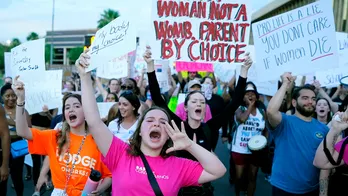Student Loan Standoff
Chris Stirewalt and Debbie Dingell discuss the student loan standoff on Capitol Hill
“$117 billion”
-- Amount of federally backed student loans obtained last year, part of a total student loan burden of more than $1 trillion.
The current election-year fracas over student loans is a microcosm of Washington dysfunction: Neither side thinks that the current system is working, but neither side is willing to take any political risks in order to fix it.
[pullquote]
Everyone in Washington knows that the status quo on student loans is unsustainable. But the Obama Democrats are staking their 2012 hopes on their ability to arouse resentment against uber-rich businessman Mitt Romney, while Republicans are desperate to deny the Blue Team another weapon in this class war.
As is the case on tax rates, entitlement programs and so many of the predictable crises gathering on the horizon for the country, the seemingly simpler college debt bubble can’t be averted because it is too useful a political weapon.
First, some background.
The Stafford Loan program (named for its patron Sen. Robert Stafford, R-Vt.) has been around since 1965 to provide subsidized student loans to lower-income students.
The loan program became a hot button in the 2006 elections, when Democrats were denouncing Republicans for not doing more to help college students. Part of the problem then was that high interest rates that resulted from the housing bubble were driving up loan prices.
Republicans responded with bipartisan legislation uncoupling Stafford Loans from market rates. Prior to 2006, the Stafford rate was set based on the interest rates the Treasury was paying on T Bills. Both parties took credit that year for cutting the effective student loan rate for needy students from 8.25 percent to 6.8 percent.
But Democrats pressed the issue, saying that if voters would turn out the GOP majority in Congress, the Blue Team would cut interest rates in half from their new lower rate. This was a persuasive pitch not just to students, but also their middle-aged parents who are often the ones who actually end up paying off the loans.
There are about 21 million post-secondary students in the country, and about a quarter of them receive subsidized government loans. This is a large enough segment of the population to be worth pandering to.
After retaking Congress, the Democrats acted swiftly to make good on the promise and voted to cut rates to their current rate of 3.4 percent in 2007. But because the budget estimates for the cost of the loan subsidy were so dire – now $6 billion a year – the Democrats set the legislation to expire after five years.
Just as Republicans had eyed the election calendar with setting the expiry of tax cuts, Democrats figured they could use the political cycle to their benefit. They timed the expiration to make it easier to extend the subsidy and make the subsidies themselves part of a re-election strategy. No one would dare oppose the extension of free money to middle-class families in an election year.
They have so far been proven right. Republicans, feeling very self-conscious about welfare programs these days, surrendered on the subject in advance of what has been a totally predictable line of attack from the Obama campaign on the subject.
The rueful irony for holders of subsidized student loans? If they could go back to the old rules before Congress started monkeying with rates six years ago in a bid to suck up to students and their parents, the current rate would be less than 1 percent.
The Panic of 2008 prompted a flight to government securities, which drove down rates on T-Bills. Since then, the Federal Reserve has printed reams and reams of money to buy up government debt in order to keep interest rates unnaturally low.
Student loan holders would have been among the greatest beneficiaries of this interest rate swoon. But in its pandering, Congress compounded the problem by not only arbitrarily setting rates, but also making them permanent. Under the old rules, rates floated with markets. The new rules would give students certainty, they said.
Here’s another certainty: If you’re paying a student loan at a rate almost 400 percent higher than you would have under the old rules, you have no recourse.
Consider this – if you qualified for a private loan with a floating rate in 2006, you may currently be paying an interest rate of less than half a point. If you didn’t qualify and got “help” from Congress, you are paying 3.4 percent.
There is an even bigger problem. America’s colleges and universities are producing graduates in the same way that a Soviet boot factory produced boots: without regard for demand.
The unemployment rate for the 20 to 24 set is 13 percent, a number hugely reduced by the ever-growing number of people in that age group who are staying in school longer. If there’s no work, and the government is subsidizing loans, why not add a graduate degree?
Stafford is far from the only government subsidy for higher educations. Pell Grants, loan forgiveness programs and other subsidies have allowed higher educational institutions to charges increasingly astronomical rates.
With fewer people actually paying full freight, schools have experienced far less blowback for massive rate hikes. But like medical costs in the era of Medicare and Medicaid, the price of tuition reflects plenty of cost shifting. The rate hikes are needed, in part, to pay to constantly expand the offerings and capacity of the institutions that have to accommodate all these new students. Lather, rinse, repeat.
The resulting bubble of student loan debt has now eclipsed $1 trillion – more than the combined credit card debt of all Americans. Jobs are hard to find and many of the debtor students sought degrees totally unrelated to the demands of the marketplace – private lenders care about the likelihood of your major to produce a salary to repay the loan, government lenders do not.
The government can keep the bubble inflated with tax dollars, but the cost of doing so will grow higher and higher. This $6 billion debate is just a foretaste.
But even dealing with the current issue, the July 1 end of the Democrats’ 2006 campaign promise for a 50 percent rate reduction, has proven beyond the abilities of the political class. Even the simple answer – going back to the system that was in place for 40 years – is an impossibility.
The president sees an opportunity to attack wealthy Romney, whose vast fortune has become an obsession for the embattled president. Just as he did on taxes and entitlements, Obama is unwilling to sacrifice an avenue of political attack in order to solve the problem.
Republicans, meanwhile, have become so phobic about being seen as cruel to the poor that few are willing to wade into such a subject.
The Republican controlled House passed an extension of the 2007 subsidy rate. While they take credit for not adding to the deficit by taking the money from the president’s health law, their version is just one more patch on the ever-inflating student debt balloon.
The Day in Quotes
“Look, Joe Biden's right. I sit in Detroit this morning David, Usama bin Laden is, indeed, dead. And GM is not just alive, it's the number one automaker in the world. I can assure you that, too, wouldn't have been the case had Mitt Romney been President of the United States.”
-- Obama campaign adviser Robert Gibbs talking to host David Gregory on “Meet the Press.”
“The president's getting some very bad advice from his campaign team, because he's diminishing the presidency by picking fake fights, going after straw men every day.”
-- House Speaker John Boehner on “State of the Union.”
"This is crazy -- he's got an opponent who basically wants to do what they did before, on steroids, which will get you the same consequences you got before, on steroids.”
-- Former President Bill Clinton at a Virginia fundraiser for President Obama attacking presumptive Republican nominee Mitt Romney.
“128”
-- The number of fundraisers held by President Obama for his re-election campaign since taking office. His predecessor held a total of 57 for his 2004 re-election campaign.
“$226 million.”
-- Outlay for the current fiscal year for “community transformation grants,” which provide free money to groups working to improve the health habits of Americans. It is the largest single expenditure for the “prevention fund” included in President Obama’s 2010 health law, a fund now targeted by House Republicans to fund an extension of student loan subsidies for lower-income students.
Chris Stirewalt is digital politics editor for Fox News, and his POWER PLAY column appears Monday-Friday on FoxNews.com.





